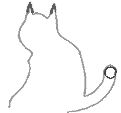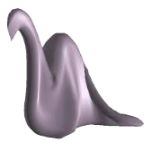Surface editing
Surface editing is a difficult problem for several reasons. First,
you're usually using a 2D input device (the mouse) to edit 3D surfaces
projected onto a 2D device. This pretty much destroys any sense of
proprioception and scale. Second, most interfaces are based around the
controls the surface representation has, such as control
points. Third, there is a trade-off between accurately capturing the
desired changes and visual smoothness - too much filtering and it
becomes difficult to make very fine changes, too little and the
surface starts to look like the someone forgot to iron it. Finally,
it's important to not only capture what the user wants to
change but also how far this change should extend.
 Representation can
play a big role in what type of interactions make sense and are easily
supported. For example, splines provide nice local control (grab a
control point and move it) but very little control over the
width of influence. Wavelets are great for controlling detail
at various levels, but their controls are very
non-intuitive. Particles or points are very flexible, and are great
for pushing around using shaped tools, but are terrible at controlling
smoothness. With Matthew Ayers (now at Microsoft) we looked at
combining these representations, and seamlessly switching between them
to support a wide variety of curve manipulation
techniques.
Representation can
play a big role in what type of interactions make sense and are easily
supported. For example, splines provide nice local control (grab a
control point and move it) but very little control over the
width of influence. Wavelets are great for controlling detail
at various levels, but their controls are very
non-intuitive. Particles or points are very flexible, and are great
for pushing around using shaped tools, but are terrible at controlling
smoothness. With Matthew Ayers (now at Microsoft) we looked at
combining these representations, and seamlessly switching between them
to support a wide variety of curve manipulation
techniques.
 Widgets allow
the user to specify not only what they want to change, but how they
want to change it. They can also provide visual controls for a
multitude of parameters. We explore widgets for sweeps, warps, and editing blends between two surfaces.
Widgets allow
the user to specify not only what they want to change, but how they
want to change it. They can also provide visual controls for a
multitude of parameters. We explore widgets for sweeps, warps, and editing blends between two surfaces.
 Sketching is another
great interface technique, but the problem is how to make sense of the
sketches, especially if they're in 3D? One solution is to project the
sketches onto walls, and so edit only two dimensions at a time.
Sketching is another
great interface technique, but the problem is how to make sense of the
sketches, especially if they're in 3D? One solution is to project the
sketches onto walls, and so edit only two dimensions at a time.
See also: representation.
Papers
- Curve
editing. This paper swapped between three different representations to
use the one best suited to the interaction task.
- Interactive
tools for editing surface blends and sweeps. Joint work with Utah,
under the auspicies of the NSF Science and Technology Center.
- Interactive tool
for editing sweeps by sketching profile curves. Works for implicit or
parametric surfaces.
- Proto type for a
3D drawing device made out of a stiff piece of paper and tracked with a camera.
- Hierarchical surface modeling for spherical surfaces.
- Raquel Bujan's Master's Thesis was a sketch-based interface for surface editing using combinations of profile curves and fall-offs.
Talks
Students
 Representation can
play a big role in what type of interactions make sense and are easily
supported. For example, splines provide nice local control (grab a
control point and move it) but very little control over the
width of influence. Wavelets are great for controlling detail
at various levels, but their controls are very
non-intuitive. Particles or points are very flexible, and are great
for pushing around using shaped tools, but are terrible at controlling
smoothness. With Matthew Ayers (now at Microsoft) we looked at
combining these representations, and seamlessly switching between them
to support a wide variety of curve manipulation
techniques.
Representation can
play a big role in what type of interactions make sense and are easily
supported. For example, splines provide nice local control (grab a
control point and move it) but very little control over the
width of influence. Wavelets are great for controlling detail
at various levels, but their controls are very
non-intuitive. Particles or points are very flexible, and are great
for pushing around using shaped tools, but are terrible at controlling
smoothness. With Matthew Ayers (now at Microsoft) we looked at
combining these representations, and seamlessly switching between them
to support a wide variety of curve manipulation
techniques.
 Widgets allow
the user to specify not only what they want to change, but how they
want to change it. They can also provide visual controls for a
multitude of parameters. We explore widgets for sweeps, warps, and editing blends between two surfaces.
Widgets allow
the user to specify not only what they want to change, but how they
want to change it. They can also provide visual controls for a
multitude of parameters. We explore widgets for sweeps, warps, and editing blends between two surfaces.
 Sketching is another
great interface technique, but the problem is how to make sense of the
sketches, especially if they're in 3D? One solution is to project the
sketches onto walls, and so edit only two dimensions at a time.
Sketching is another
great interface technique, but the problem is how to make sense of the
sketches, especially if they're in 3D? One solution is to project the
sketches onto walls, and so edit only two dimensions at a time.